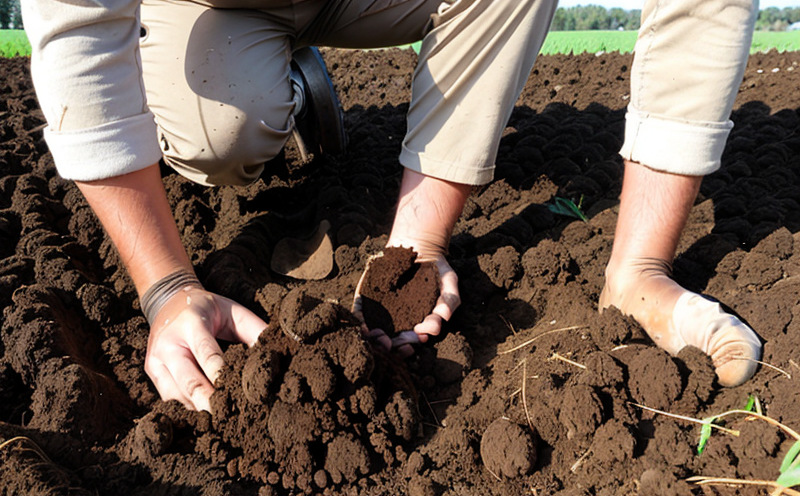Soil Root Zone Depth Testing
The soil root zone depth is a critical parameter that influences crop growth, nutrient uptake, and overall plant health. Understanding the depth at which roots can effectively function helps in optimizing agricultural practices to enhance productivity and sustainability. This test evaluates the depth of the soil layer where most roots grow, ensuring that crops receive adequate water and nutrients.
The root zone typically extends from the soil surface down to the point where roots encounter a significant change in physical properties or moisture levels. Factors such as texture, structure, and organic matter content influence this depth. By accurately determining the root zone depth, farmers can make informed decisions about irrigation schedules, fertilizer application rates, and tillage practices.
For instance, crops like maize have deeper root zones compared to those of wheat. Understanding these differences allows for tailored agricultural strategies that maximize yield without overusing resources. This test is particularly important in precision agriculture, where every detail can lead to significant improvements in efficiency and environmental impact.
The testing procedure involves digging a trench at the site of interest, typically 1-2 meters deep, depending on the expected root depth. Soil samples are collected from various depths within this trench using a soil auger or similar tool. The samples are then analyzed for physical properties such as texture, structure, and organic matter content.
Instrumentation used in this process includes soil moisture probes, penetrometers, and sometimes even ground-penetrating radar (GPR) to assess the extent of root penetration. These tools provide a detailed profile of the soil characteristics within the root zone, which is essential for accurate testing.
The acceptance criteria for this test are based on internationally recognized standards such as ISO 17240-6:2018 and EN 359:2014. These guidelines ensure that the testing methods are consistent and reliable across different regions, allowing for comparability of results.
The importance of soil root zone depth testing cannot be overstated in modern agriculture. It provides a foundation for sustainable practices by optimizing resource use and enhancing crop yields. This service helps quality managers, compliance officers, R&D engineers, and procurement professionals make evidence-based decisions that contribute to environmental stewardship and economic efficiency.
By understanding the root zone depth, agriculturalists can better manage soil health, leading to more resilient crops capable of withstanding environmental stresses such as droughts or floods. This knowledge also supports efforts in reducing chemical inputs while maintaining high productivity levels.
Applied Standards
| Standard | Description |
|---|---|
| ISO 17240-6:2018 | This international standard provides guidelines for soil sampling and analysis, including procedures for determining root zone depth. |
| EN 359:2014 | An EU harmonized standard that specifies the methods for measuring soil physical properties relevant to root growth. |
| ASTM D6186-17 | This American Society for Testing and Materials standard outlines procedures for determining root zone depth using ground-penetrating radar (GPR). |
| IEC 62305:2014 | An international standard that addresses the safety requirements for electrical equipment used in agricultural environments, which can include soil testing instruments. |
Why Choose This Test
The importance of soil root zone depth testing lies not only in its ability to provide accurate data but also in the practical applications it offers. Farmers and agriculturalists can use this information to optimize irrigation schedules, reducing water usage while ensuring plants receive sufficient moisture.
Moreover, by understanding where roots grow deepest, farmers can apply fertilizers more precisely, targeting areas where they are most needed rather than uniformly across the field. This targeted approach not only saves money but also reduces environmental impact by minimizing the use of chemical inputs.
The test is particularly valuable in precision agriculture, where data-driven decision-making is crucial for maximizing efficiency and sustainability. It helps in reducing soil compaction issues that can occur from heavy machinery, which is common in large-scale farming operations. By knowing the root depth, farmers can plan their tillage practices more effectively, leading to better soil structure and enhanced aeration.
Additionally, this test supports efforts in sustainable agriculture by promoting practices that protect natural resources. It helps in maintaining healthy soil ecosystems, which are vital for long-term productivity and resilience against climate change impacts.
The data obtained from root zone depth testing can also be used to inform land use planning decisions. For example, identifying areas with limited root growth due to poor soil conditions can guide the selection of appropriate crops or suggest interventions such as organic matter addition or soil amendments.
Environmental and Sustainability Contributions
The practice of soil root zone depth testing plays a crucial role in environmental stewardship by promoting sustainable agricultural practices. By optimizing resource use, this test helps reduce the carbon footprint associated with agriculture, contributing to global efforts aimed at mitigating climate change.
Water conservation is one of the primary benefits of accurate root zone depth determination. Overwatering can lead to increased water consumption and potential runoff into nearby water bodies, causing pollution and ecological harm. Conversely, under-watering can stunt plant growth, leading to reduced yields. Understanding the exact depth at which roots grow ensures that irrigation systems are set up to deliver just enough water, minimizing waste.
Fertilizer application is another area where this test proves invaluable. By knowing the depth of root growth, farmers can apply fertilizers more efficiently, targeting areas where they will have the most impact. This targeted approach reduces the amount of fertilizer needed overall while ensuring that nutrients are available when and where plants need them most.
The test also supports efforts in reducing soil erosion by helping to identify areas prone to erosion due to shallow root systems. Implementing appropriate conservation practices, such as cover cropping or terracing, can help prevent these issues, preserving valuable topsoil for future generations.
Furthermore, this testing contributes to the overall health of agroecosystems by promoting biodiversity and supporting beneficial soil organisms. Healthy soils are better able to withstand environmental stresses, leading to more resilient crops that require fewer interventions in times of adversity.





